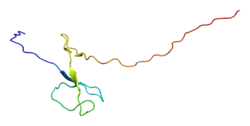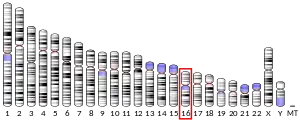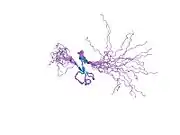| NOB1 | |||||||||||||||||||||||||||||||||||||||||||||||||||
|---|---|---|---|---|---|---|---|---|---|---|---|---|---|---|---|---|---|---|---|---|---|---|---|---|---|---|---|---|---|---|---|---|---|---|---|---|---|---|---|---|---|---|---|---|---|---|---|---|---|---|---|
 | |||||||||||||||||||||||||||||||||||||||||||||||||||
| Identifiers | |||||||||||||||||||||||||||||||||||||||||||||||||||
| Aliases | NOB1, ART-4, MST158, NOB1P, PSMD8BP1, MSTP158, NIN1/PSMD8 binding protein 1 homolog, NIN1 (RPN12) binding protein 1 homolog | ||||||||||||||||||||||||||||||||||||||||||||||||||
| External IDs | OMIM: 613586 MGI: 1914869 HomoloGene: 31924 GeneCards: NOB1 | ||||||||||||||||||||||||||||||||||||||||||||||||||
| |||||||||||||||||||||||||||||||||||||||||||||||||||
| |||||||||||||||||||||||||||||||||||||||||||||||||||
| |||||||||||||||||||||||||||||||||||||||||||||||||||
| |||||||||||||||||||||||||||||||||||||||||||||||||||
| |||||||||||||||||||||||||||||||||||||||||||||||||||
| Wikidata | |||||||||||||||||||||||||||||||||||||||||||||||||||
| |||||||||||||||||||||||||||||||||||||||||||||||||||
RNA-binding protein NOB1 is a protein that in humans is encoded by the NOB1 gene.[5][6]
References
- 1 2 3 GRCh38: Ensembl release 89: ENSG00000141101 - Ensembl, May 2017
- 1 2 3 GRCm38: Ensembl release 89: ENSMUSG00000003848 - Ensembl, May 2017
- ↑ "Human PubMed Reference:". National Center for Biotechnology Information, U.S. National Library of Medicine.
- ↑ "Mouse PubMed Reference:". National Center for Biotechnology Information, U.S. National Library of Medicine.
- ↑ Zhang Y, Ni J, Zhou G, Yuan J, Ren W, Shan Y, Tang W, Yu L, Zhao S (Sep 2005). "Cloning, expression and characterization of the human NOB1 gene". Mol Biol Rep. 32 (3): 185–9. doi:10.1007/s11033-005-3141-7. PMID 16172919. S2CID 12892523.
- ↑ "Entrez Gene: NOB1 NIN1/RPN12 binding protein 1 homolog (S. cerevisiae)".
Further reading
- Olsen JV, Blagoev B, Gnad F, et al. (2006). "Global, in vivo, and site-specific phosphorylation dynamics in signaling networks". Cell. 127 (3): 635–48. doi:10.1016/j.cell.2006.09.026. PMID 17081983. S2CID 7827573.
- Gerhard DS, Wagner L, Feingold EA, et al. (2004). "The status, quality, and expansion of the NIH full-length cDNA project: the Mammalian Gene Collection (MGC)". Genome Res. 14 (10B): 2121–7. doi:10.1101/gr.2596504. PMC 528928. PMID 15489334.
- Lehner B, Sanderson CM (2004). "A protein interaction framework for human mRNA degradation". Genome Res. 14 (7): 1315–23. doi:10.1101/gr.2122004. PMC 442147. PMID 15231747.
- Ota T, Suzuki Y, Nishikawa T, et al. (2004). "Complete sequencing and characterization of 21,243 full-length human cDNAs". Nat. Genet. 36 (1): 40–5. doi:10.1038/ng1285. PMID 14702039.
- Fatica A, Oeffinger M, Dlakić M, Tollervey D (2003). "Nob1p is required for cleavage of the 3' end of 18S rRNA". Mol. Cell. Biol. 23 (5): 1798–807. doi:10.1128/MCB.23.5.1798-1807.2003. PMC 151717. PMID 12588997.
- Strausberg RL, Feingold EA, Grouse LH, et al. (2003). "Generation and initial analysis of more than 15,000 full-length human and mouse cDNA sequences". Proc. Natl. Acad. Sci. U.S.A. 99 (26): 16899–903. Bibcode:2002PNAS...9916899M. doi:10.1073/pnas.242603899. PMC 139241. PMID 12477932.
- Daniele A, Altruda F, Ferrone M, et al. (1992). "Cloning and expression of a new human polypeptide which regulates protein phosphorylation in Escherichia coli". Mol. Cell. Biochem. 107 (2): 87–94. doi:10.1007/bf00225511. PMID 1791827. S2CID 25617287.
This article is issued from Wikipedia. The text is licensed under Creative Commons - Attribution - Sharealike. Additional terms may apply for the media files.




